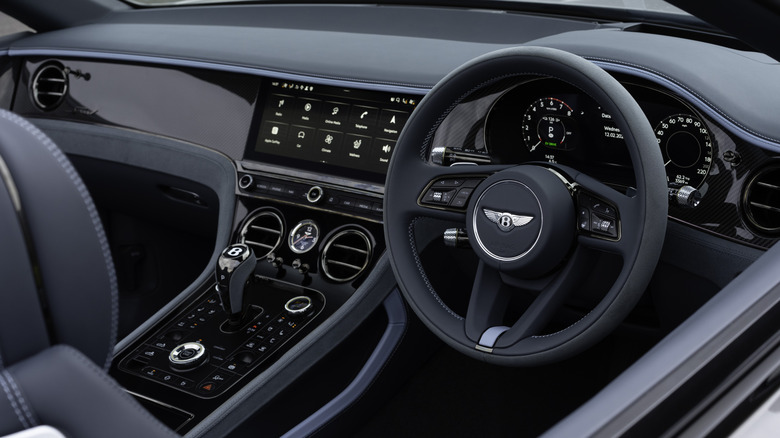What Kind Of Wood Is Used In A Bentley?
The interior of a Bentley speaks volumes about the automaker's mission and illustrious history. W.O Bentley founded the company in 1919 to "make a fast car, a good car, the best in its class," according to the Bentley website. In keeping with his goals, the automaker that carries his name continues to take no shortcuts in creating production cars that perform well and have comfortable, impeccably crafted interiors. One visual highlight of a Bentley's cabin are the real wood veneers that cover the door panels and dashboard of models like the 2026 Continental GT and Flying Spur.
With Bentley's century-old tradition to uphold, the company employs a meticulous selection, treatment, and mounting process to get things just right. Bentley uses walnut, koa, and oak to make veneers for its existing vehicles, with each wood giving a distinct look. Bentley's craftspeople use a mirror-matching process when laying out the veneers, which lines up the grain even across the gaps and seams between panels. The veneers are also tested to make sure they'll stand up to temperature fluctuations, high humidity, and UV exposure. Bentley uses walnut, koa, and redwood burl (which grows on the roots and is shed naturally as the trees grow) in its cars.
Wood for Bentley veneers is sustainably sourced
Bentley gets much of its wood from the United States, including vavona (the burl from California redwoods), koa from Hawaii, and crown cut black walnut from central and eastern North America. Each panel complies with Forestry Stewardship Commission standards, and Bentley works with walnut farmers to buy trees that are done producing nuts and are to be felled anyway to address deforestation concerns. In addition, the Bentley wood experts avoid sourcing from regions where they can't be sure of the wood's origin.
Bentley's customization department gives clients the option to choose their own wood for bespoke panels, but won't guarantee the quality of the final work if they make veneers from unfamiliar materials. Bentley's wood veneers are carefully made to complement other premium touches inside the cars, like fine leather, high-quality carpet, and chrome trim. It's not an easy process to make and fit them, but the results are apparent the instant you look or sit inside a Bentley.
Bentley's veneers are carefully crafted
It takes a lot of work to transform freshly cut wood into a gorgeous vehicle interior. The Bentley production team sources wood between six and eight times per year, and is very particular about the quality of wood it buys. Each wood veneer is about 0.6 millimeters thick, and a new Bentley requires 16 to 33 square feet (5-10 square meters) to cover the dashboard, doors, and other interior surfaces.
Since Bentley is part of the Volkswagen Group, the wood must be tested to make sure it conforms to the standards of both companies. One of Bentley's tests involves installing veneers in a car, then sending it to Arizona to sit in the punishing desert sun for as long as two years.
Each panel undergoes a 72-hour curing process before being sanded, lacquered, and polished, and some veneers are heat or chemically treated as well. Bentley is constantly refining the process with new materials and installation techniques, like the world's first 3D wood panels that debuted in a few years ago in the Flying Spur. In addition to wood, Bentley buyers can choose from carbon fiber, turned aluminum, or beautiful, first-of-their-kind stone veneers.


